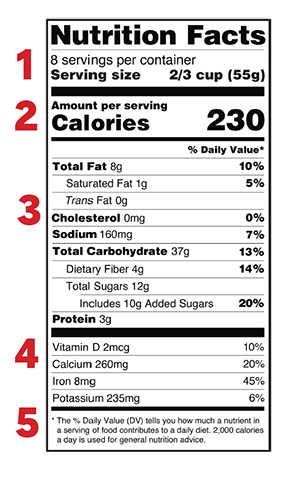Understanding Food Nutrition Labels
Learning how to understand and use the Nutrition Facts label can help you make healthier eating choices and identify nutrient-dense foods for a healthy diet. Here are some tips from the American Heart Association for making the most of the information on food labels.
Learn what to look for on the label.

1 - Start with the serving information at the top.
This will tell you the size of a single serving and the total number of servings per container (package).
2 - Next, check total calories per serving and container.
Pay attention to the calories per serving and how many calories you’re really consuming if you eat the whole package. If you double the servings you eat, you double the calories and nutrients.
The next section of information on a nutrition label is about the amounts of specific nutrients in the product.
3 - Limit certain nutrients.
Check key nutrients and understand what you’re looking for. Not all fats are bad , and total sugars can include both natural and added sugars. Limit the amounts of added sugars , saturated fat and sodium you eat, and avoid trans fat. When choosing among different brands or similar products, compare labels and choose foods with less of these nutrients when possible..
4 - Get enough of the beneficial nutrients.
Make sure you get enough of the nutrients your body needs, such as: calcium, choline, dietary fiber, iron, magnesium, potassium, and vitamins A, C, D and E.*
5 - Understand % Daily Value.
The % Daily Value (DV) tells you the percentage of each nutrient in a single serving, in terms of the daily recommended amount. If you want to consume less of a nutrient (such as saturated fat or sodium), choose foods with a lower % DV (5 percent or less). If you want to consume more of a nutrient (such as fiber), choose foods with a higher % DV (20 percent or more).
Here are more tips for getting as much health information as possible from the Nutrition Facts label:
- Remember that the information shown in the label is based on a diet of 2,000 calories a day. You may need less or more than 2,000 calories depending upon your age, gender, activity level, and whether you’re trying to lose, gain or maintain your weight.
- When the Nutrition Facts label says a food contains “0 g” of trans fat, but includes “partially hydrogenated oil” in the ingredient list, it means the food contains some trans fat, but less than 0.5 grams per serving. So, if you eat more than one serving, you could end up eating too much trans fat.
- The U.S. Food and Drug Administration (FDA) regulates the Nutrition Facts label seen on packaged foods and drinks. In 2016, the FDA released changes to the label to make it easier to see how many calories and added sugars are in a product and to make serving sizes more realistic. These changes are still being implemented throughout the food industry, so for now you may see the redesigned version shown here or the old original version.
*Source: 2015-2020 Dietary Guidelines for Americans








